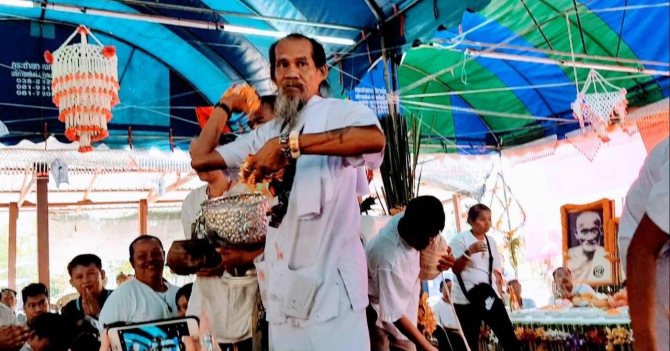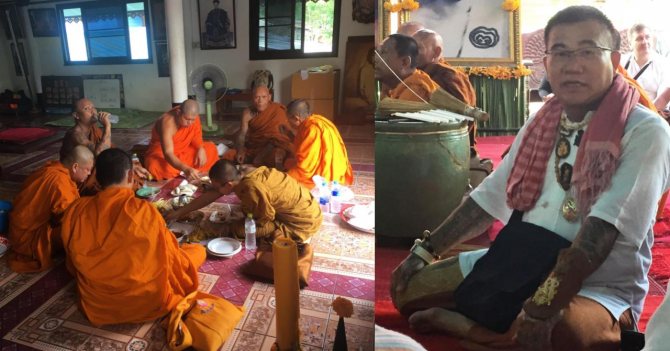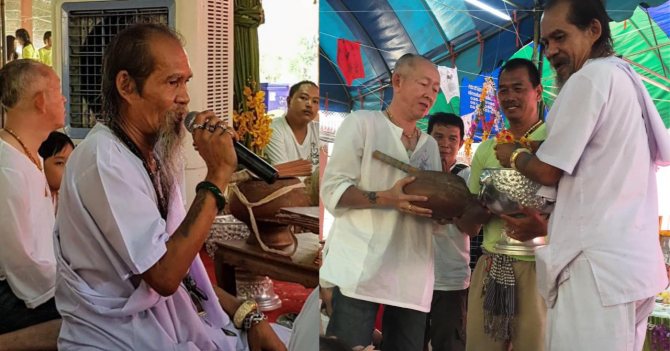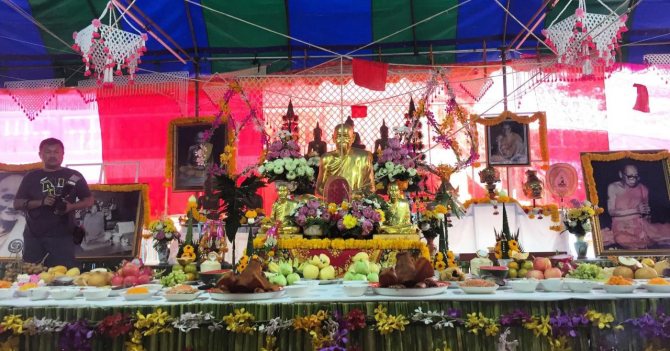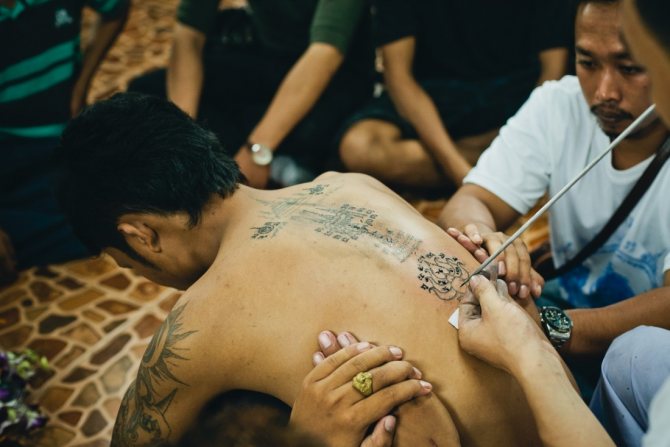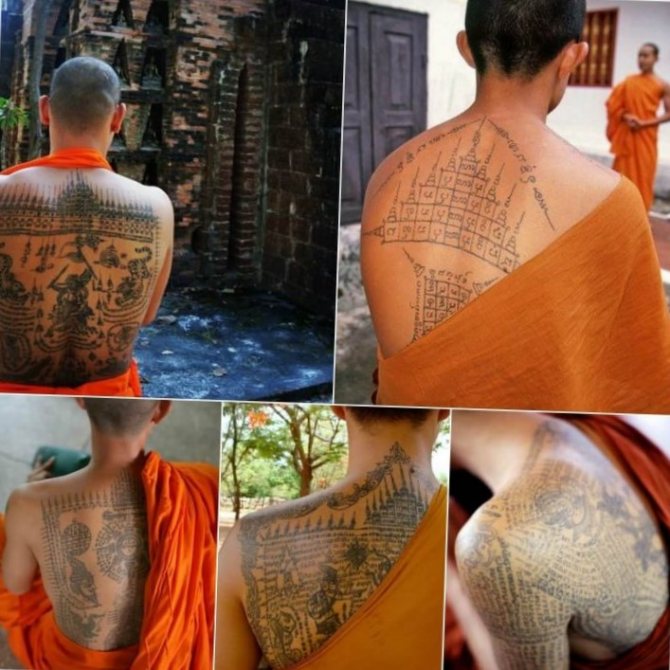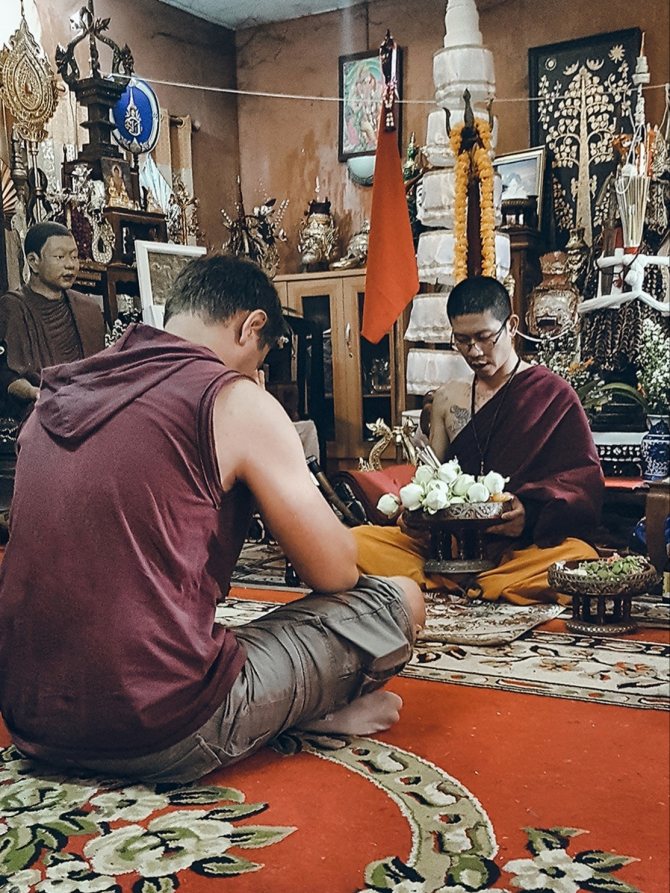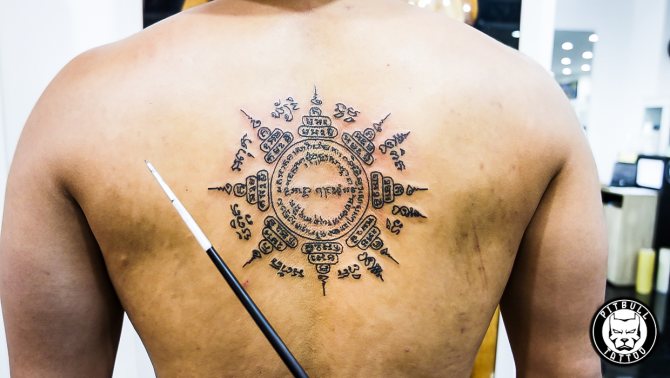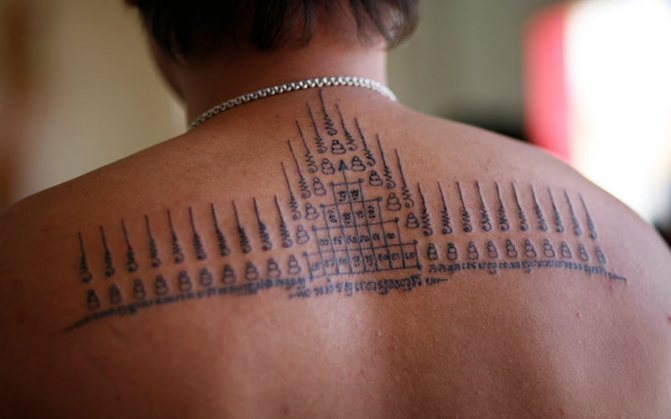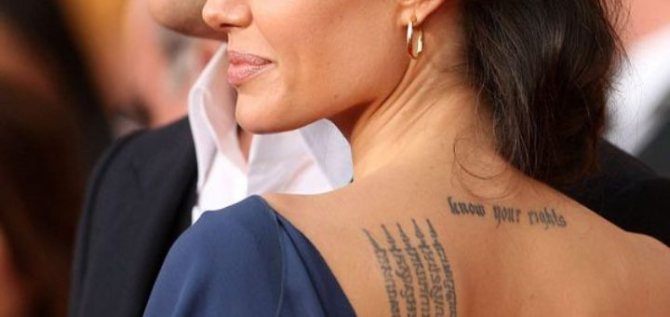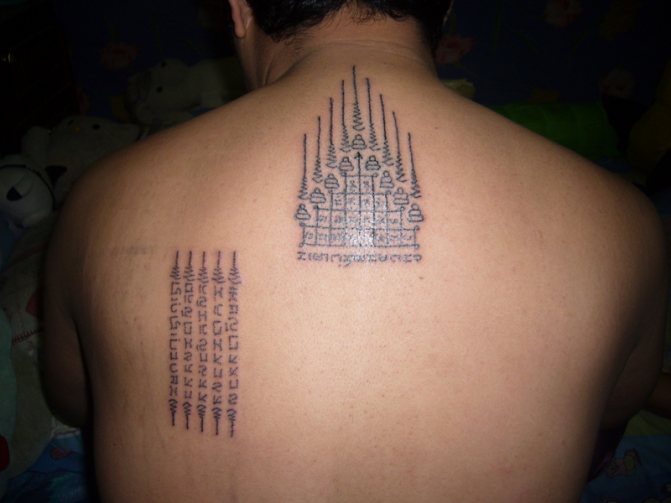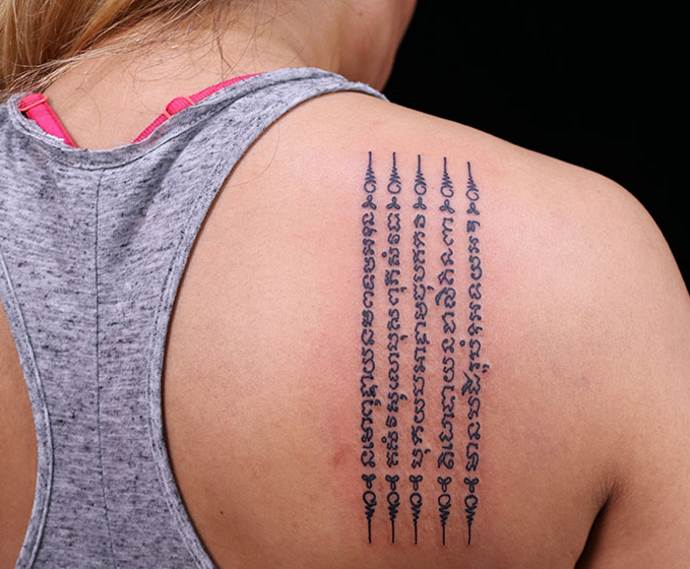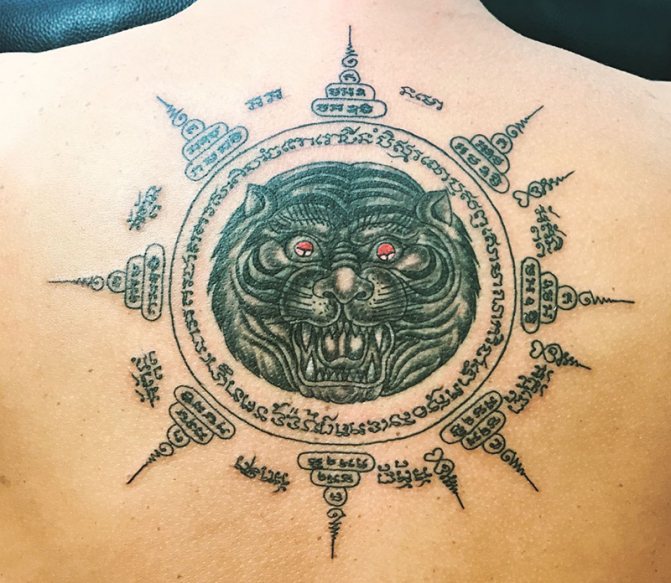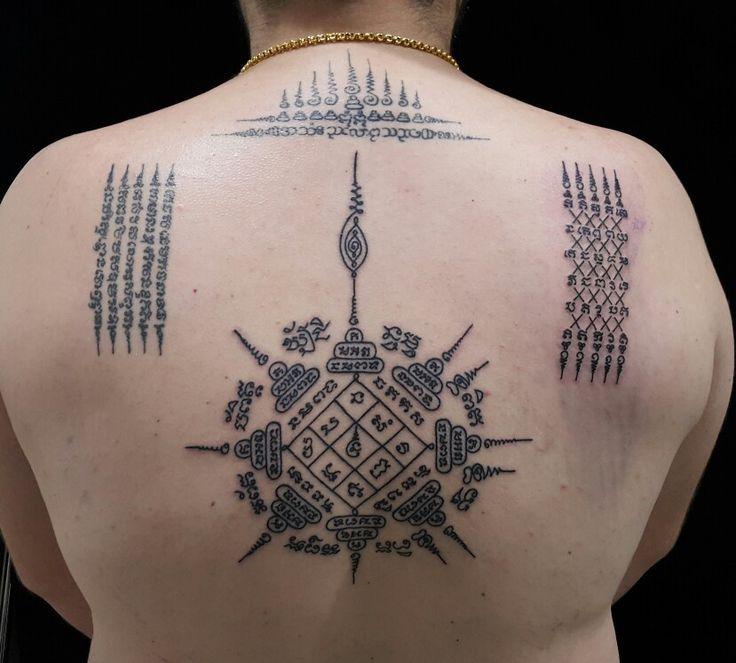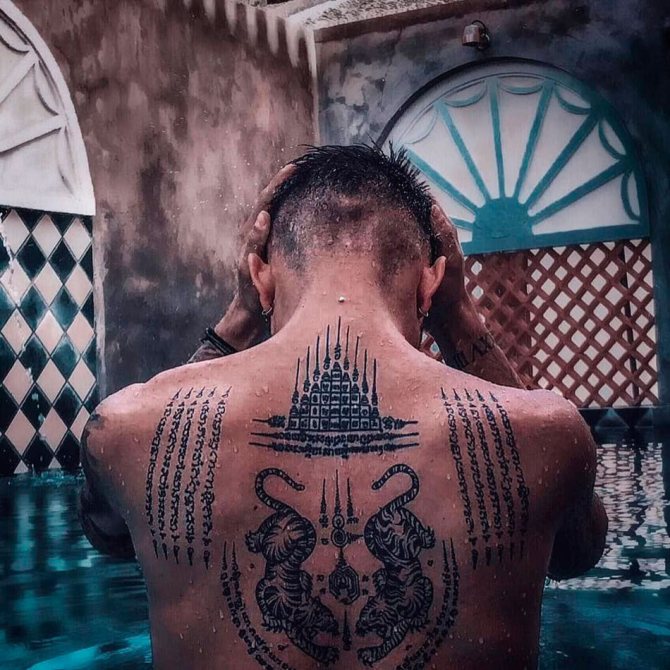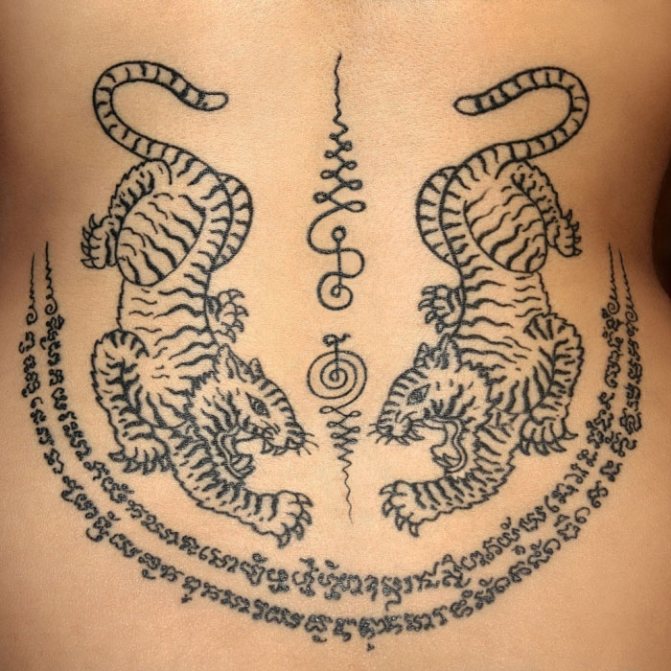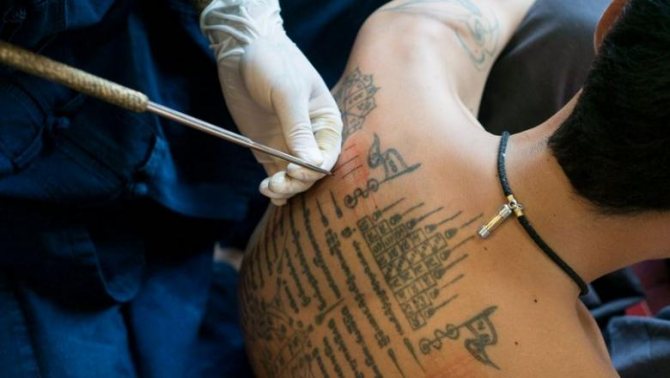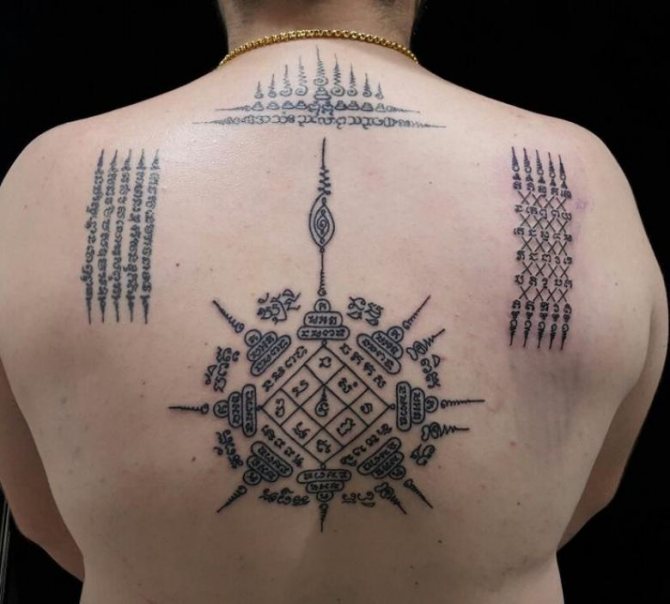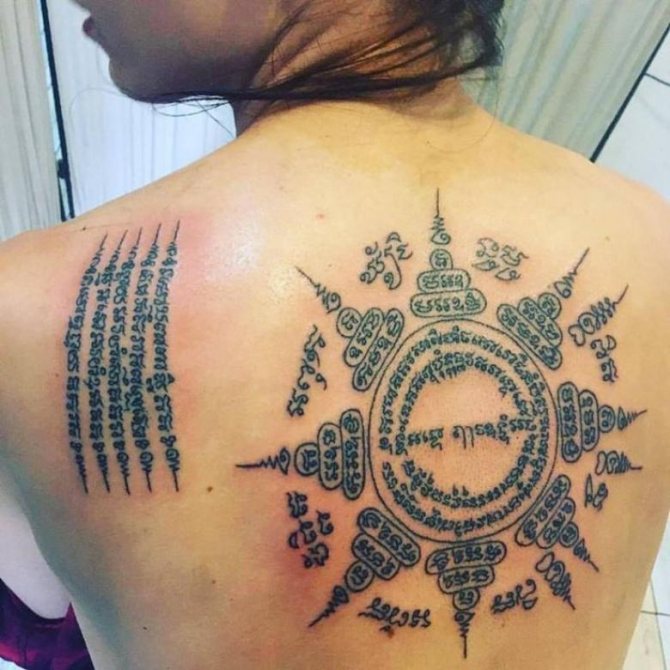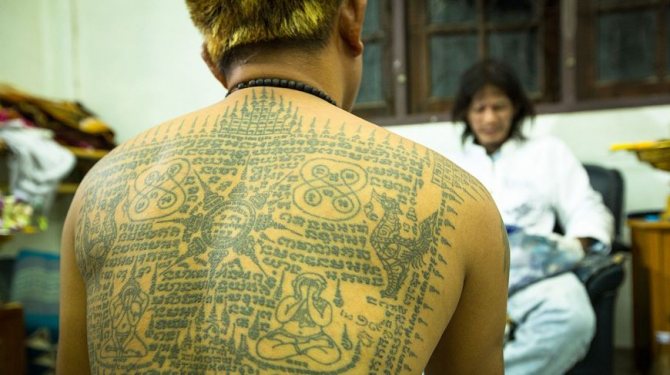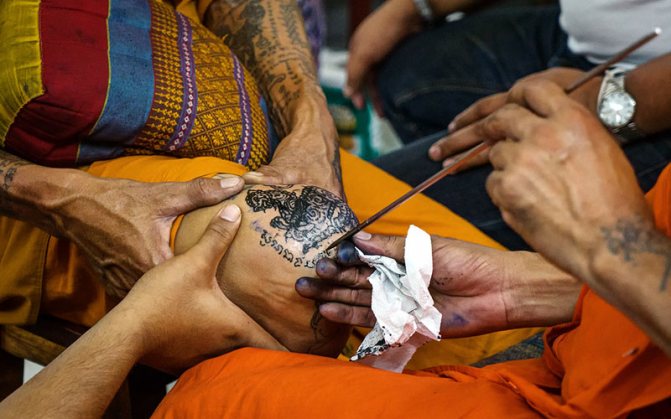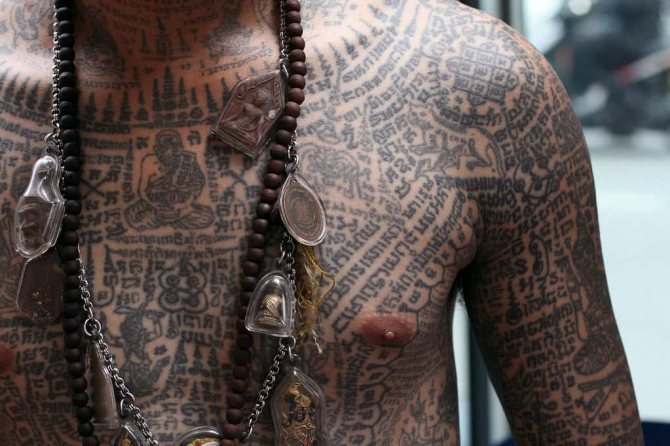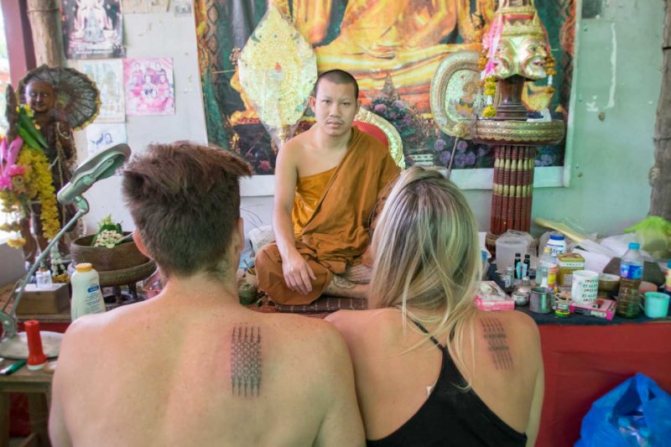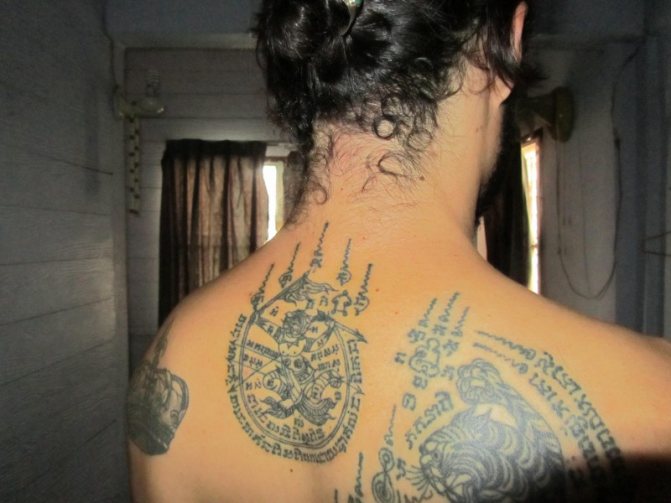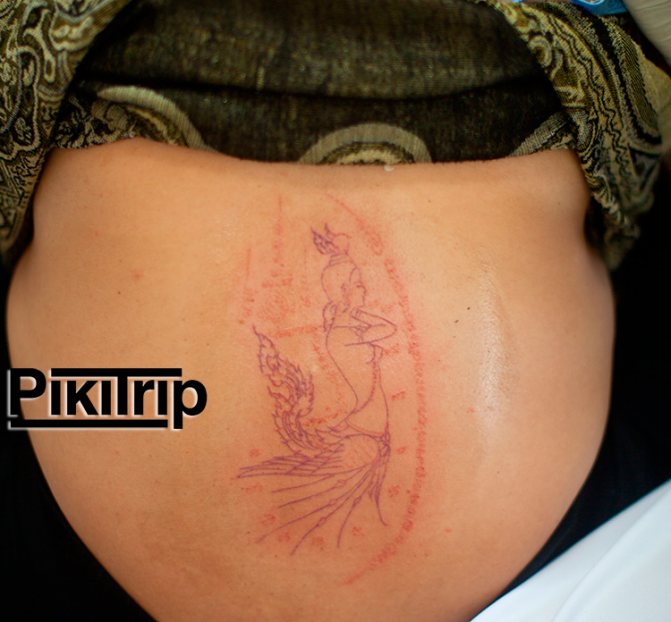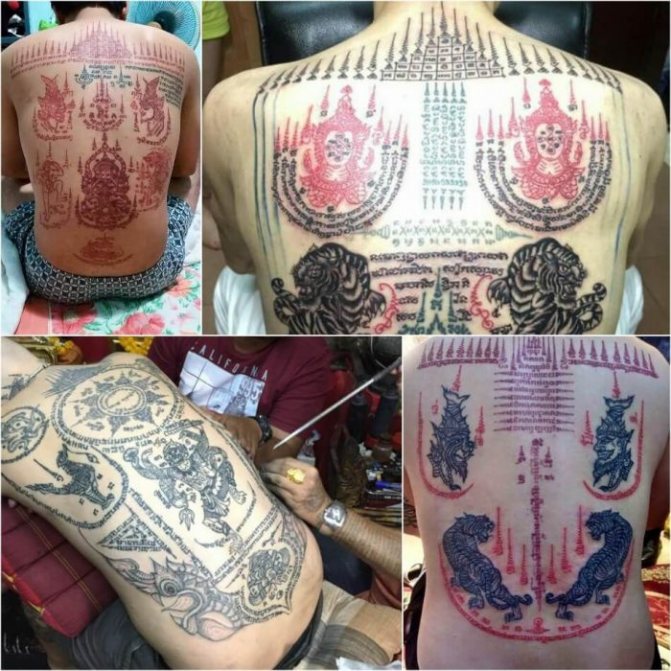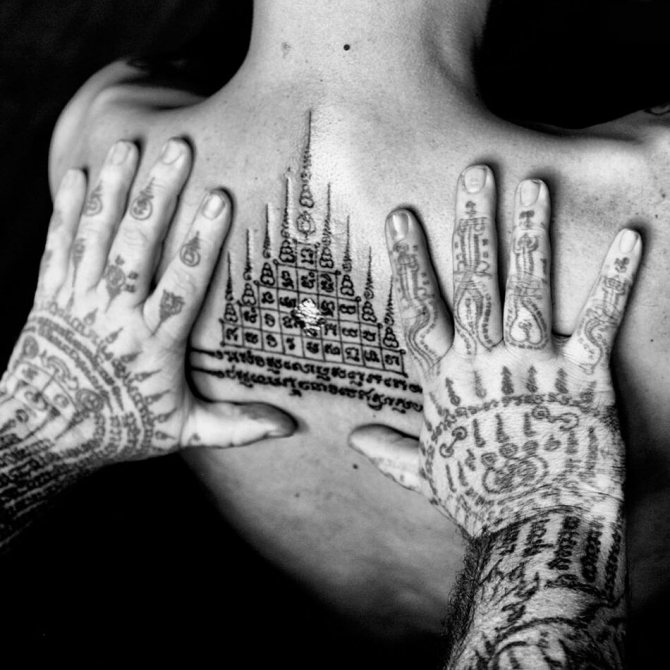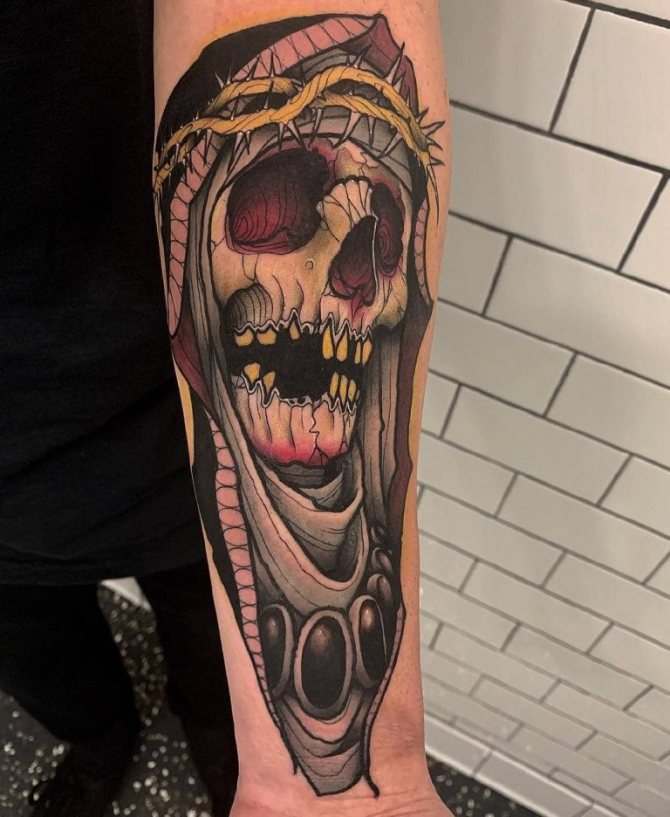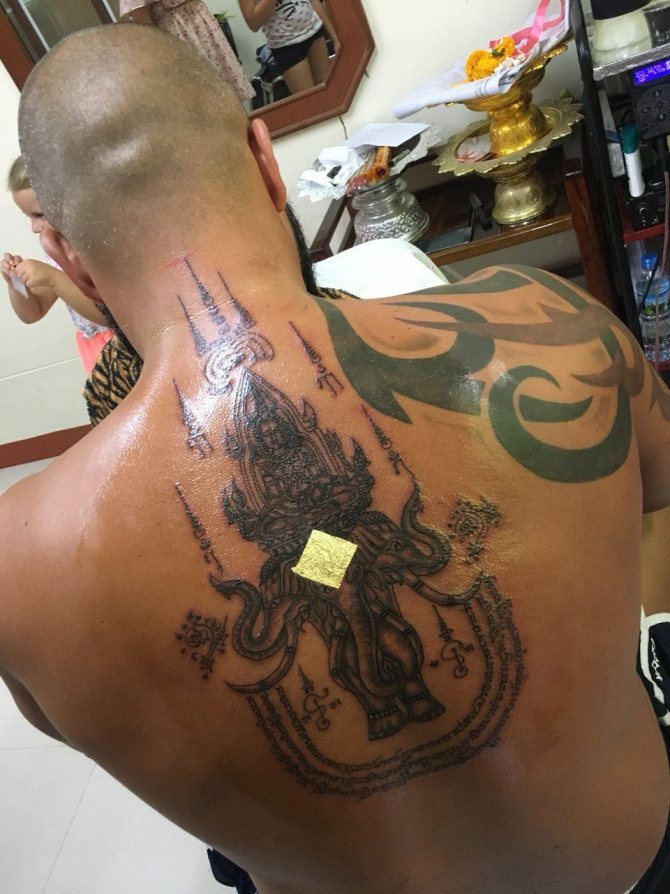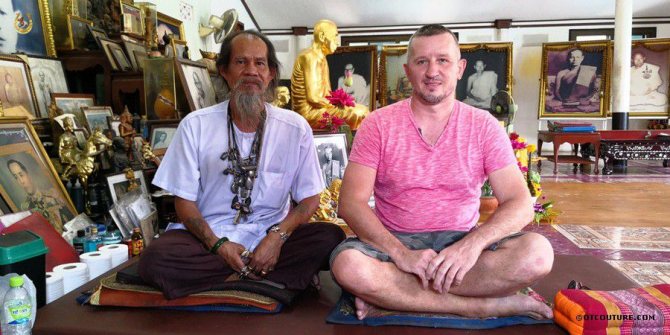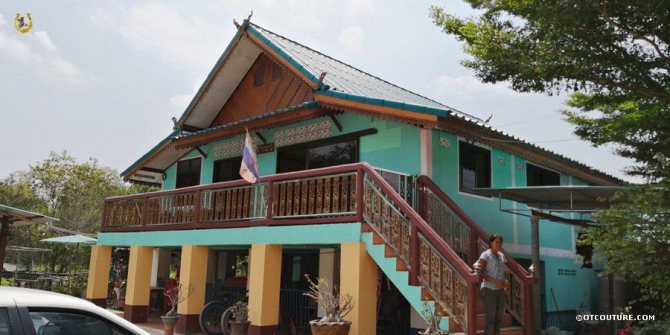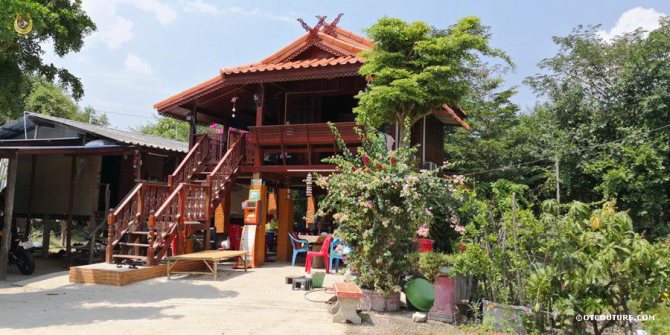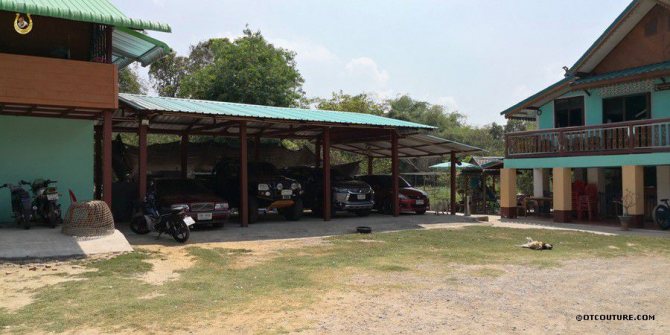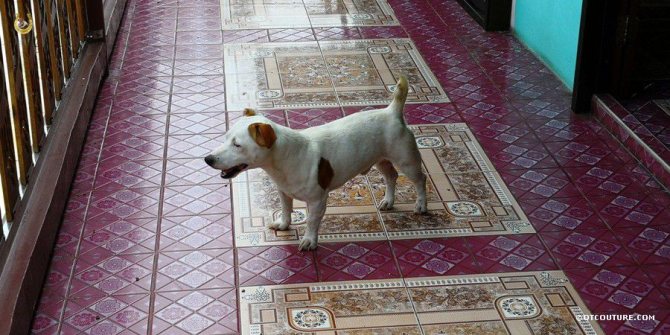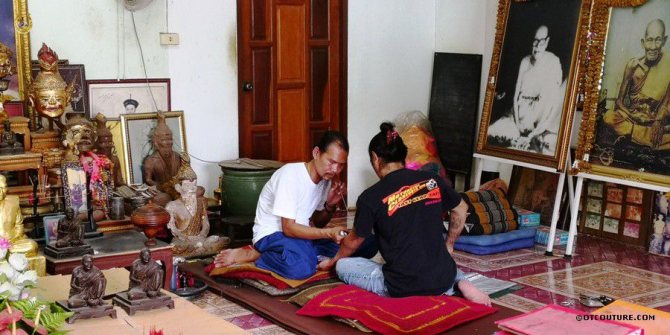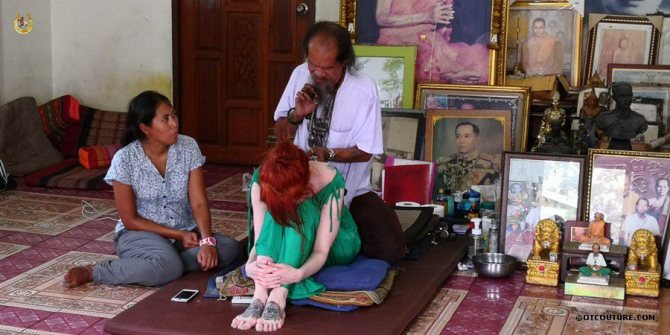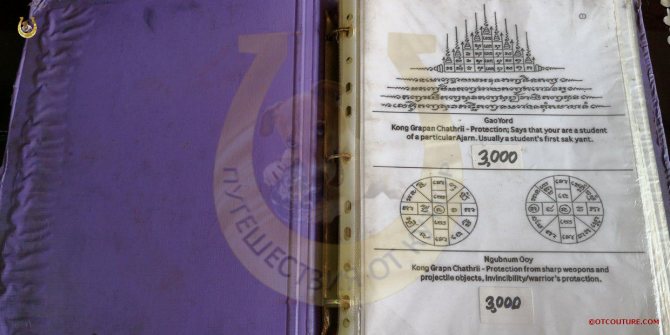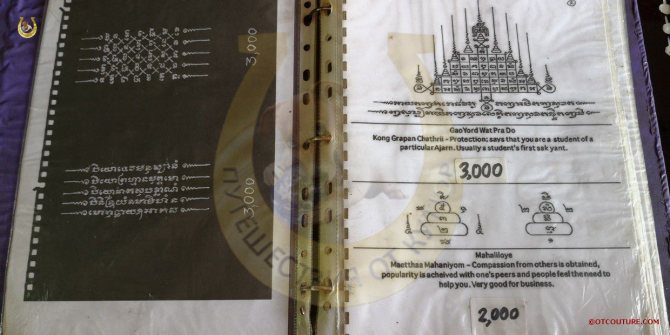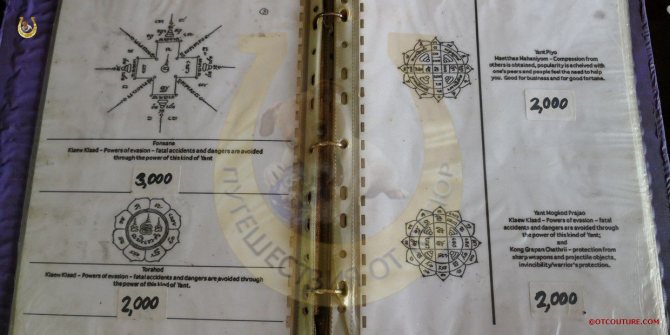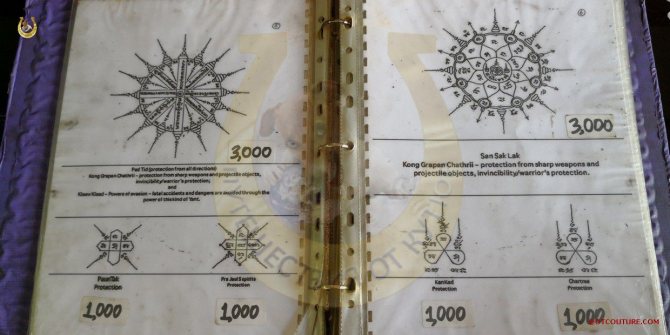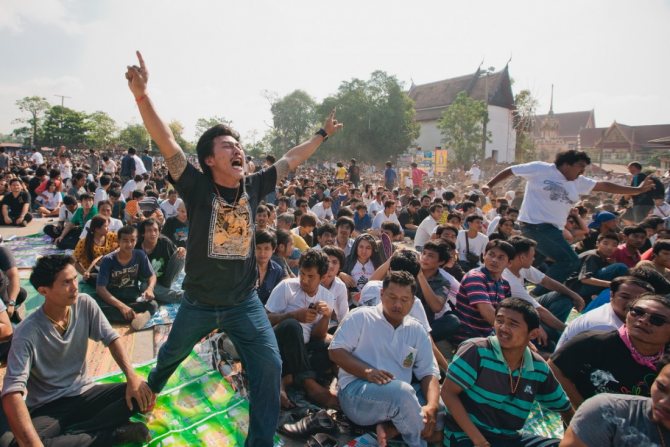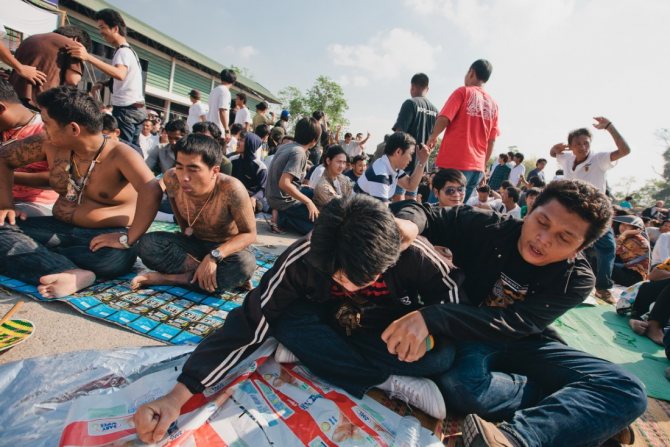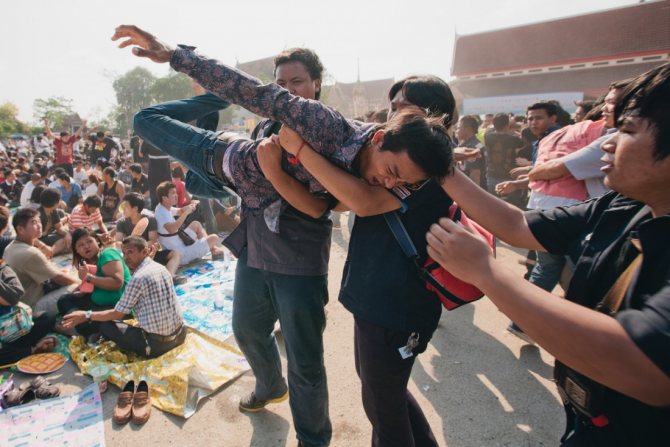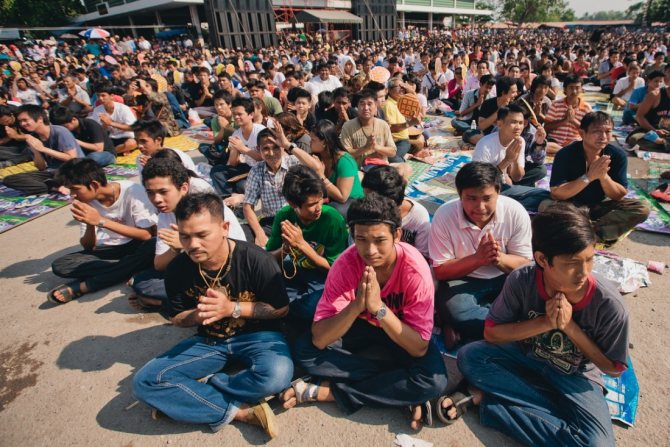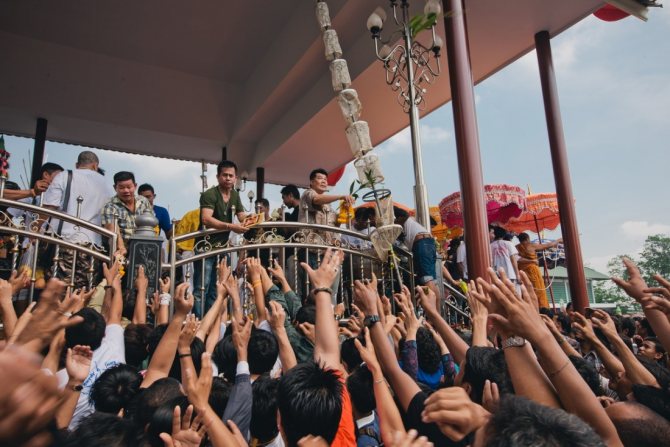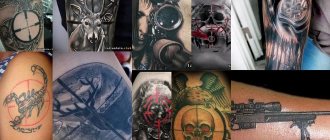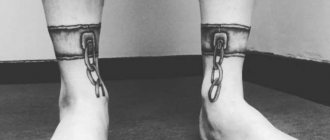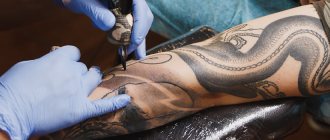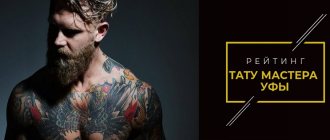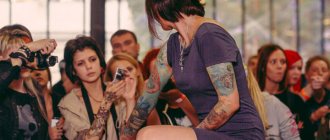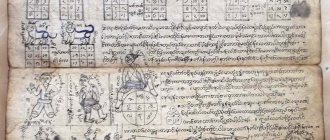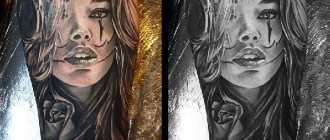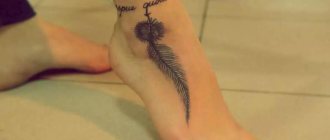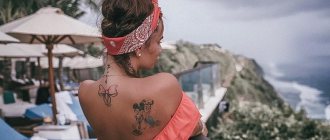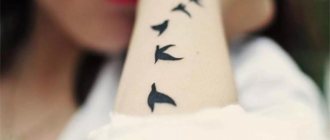Yantra tattoo, also called Sak Yant, is a type of tattoo practiced in Southeast Asian countries, including Cambodia, Laos and Thailand. It has also begun to grow in popularity among Chinese Buddhists in Singapore. "Sak" means "to pad" tattoo, and "Yant" is the Thai pronunciation of the Sanskrit word "Yantra."
Sak Yant drawings are usually done by people practicing magic (called wicha) and Buddhist monks, traditionally done with a long bamboo stick (mai sak) pointed at the end, or a long metal spike (khem sak).
History
Yantra tattoos originated in Cambodia, where images of the ancient Khmer writing were used. During the time of the Great Khmer Empire all wars were covered with tattoos from head to toe, including chest, arms and even fingers. King Jayavarman VII, tested the efficacy of the tattoo on his own body by being struck by arrows which all bounced off his chest. Proof of this fact was recorded in Zhou Daguan's diary. Chinese chronicles describe Yantra tattoos in the Thai culture of Southwest China and Northwest Vietnam dating back at least 2,000 years. As the centuries passed, the tradition spread through the territories occupied by present-day Thailand, Laos, Cambodia and parts of Myanmar. Today, the Sak Yant tattoo tradition is most popular in Thailand, while in Cambodia and Laos it has all but disappeared.
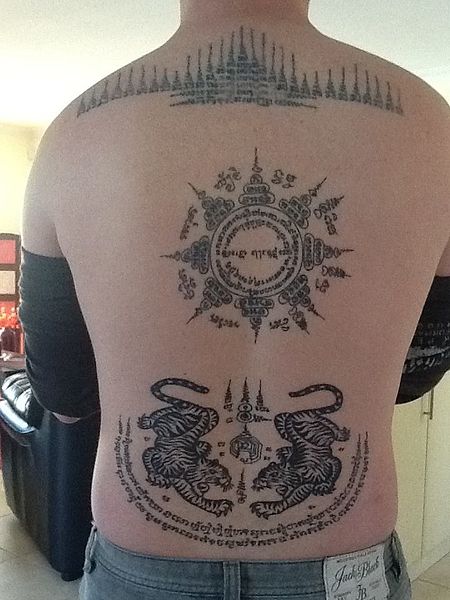
The script used in Yantra tattoos differs according to cultural and geographical factors. Cambodia and Central Thailand use Khmer script, while Northern Thailand prefers Yantra tattoos with Shan, Northern Thai or Tai Lu script and Laos uses Lao Tham language. The writings depict the abbreviated syllables of the Pali incantations. Over the centuries, different masters have made their own additions to the design based on visions received in meditations. Some Yantra images were adopted from pre-Buddhist Shamanism and belief in animal spirits found in the Southeast Asian subcontinent and incorporated into Thai tradition and culture.
Mystical paintings - Sak Yant tattoo
These variants were originally mentioned in ancient Chinese chronicles in the 1st century BC. Warrior garments were equipped with yantras, representing a protective shield against enemy weapons.
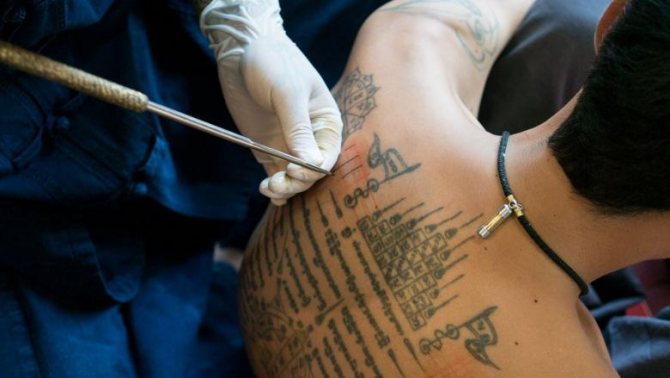

As time passed, the image filled the Philippine islands and Indonesia, aided by the spreading teachings of Buddhism. Mantras are written in the Indian dialect of Pali, the birthplace of the Buddha. In this language the writing has been replaced by certain Khmer characters.
According to this fact, we can conclude that the Sak Yant is a Vedic Khmer prayer. The outward sameness is quite deceptive - the hieroglyphs, folded into a concise geometric form, differ in the significance they contain. In general, it is a desire for material independence and deliverance from enemies. The ornament exudes immense magical power.
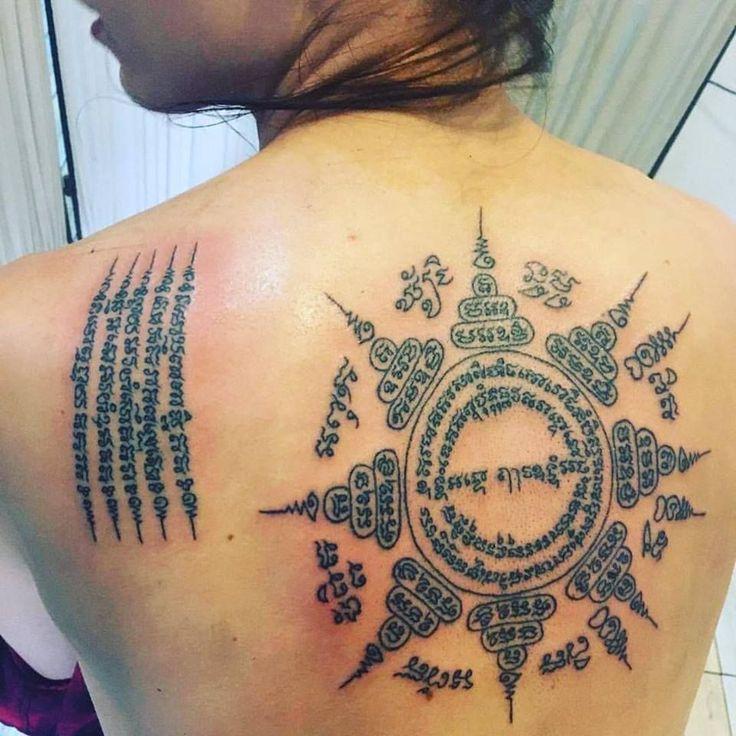

Meaning
It is believed that tattoos with Yantra symbols have magical and mystical power, protect and bring good luck.
In Cambodia, tattoos are used for self-protection. Cambodians believe that Yantras are endowed with magical power to ward off evil and deprivation. Tattoos are especially popular among the military. They serve as a kind of guarantee that the person will not suffer any physical harm as long as he complied with all the certain rules.
Yant drawing are also applied to many other objects such as cloth or metal, they are put in the house, a place of worship or a vehicle, as a means of protection against danger or disease, to increase prosperity or attract a lover.
Types and Designs
There are many traditional types and designs of Yantra tattoos. Some of the best known and most popular include:
- Onk Phra/Ongk Phra. ( translation: Buddha's body) is one of the most common elements in Yantra tattooing, but can also be a complex stand-alone image. It is meant to provide insight, direction, illumination, etc.
- Ha Thaew (translation: five lines) is one of the most common Yantra drawings for women in Thailand, also used for men. It is usually applied to the back of the left shoulder. Each of the five lines implies a different blessing for success and good luck.
- Gao Yod/Kao Yord ( translation: nine spires) - usually tattooed in the center of the upper back in various sizes and levels of complexity.
- Sii Yord. ( translation: four spires). The tattoo is intended to influence the feelings and actions of others and to protect the bearer of the image.
- Paed Tidt (translates: eight dots) gives protection in the eight directions of the universe. The tattoo is round and is usually placed in the center of the back.
- Sip Tidt (A variant of the Sip Tidt tattoo, it's different in that it gives protection in ten directions instead of eight.
- Mahaniyom (translation: great preference). The tattoo gives the wearer favor in the eyes of others. The image is round, and is usually placed on the back of the right shoulder.
- Yord Mongkut (Translation: pointed crown) - designed for good luck and protection in battle. This is a round-shaped tattoo, usually placed on top of the head.
- Bpanjamukhee (translates: five faces of Virgo) - tattoo is intended to ward off disease and danger.
- Suea (Translation: tiger) - usually on the tattoo depicts twin tigers. Symbolizes strength and power.
On what place to score a tattoo?
The question that bothers almost anyone who has decided to put this image - where correctly and aesthetically placed pattern: in the open or closed areas of the body.
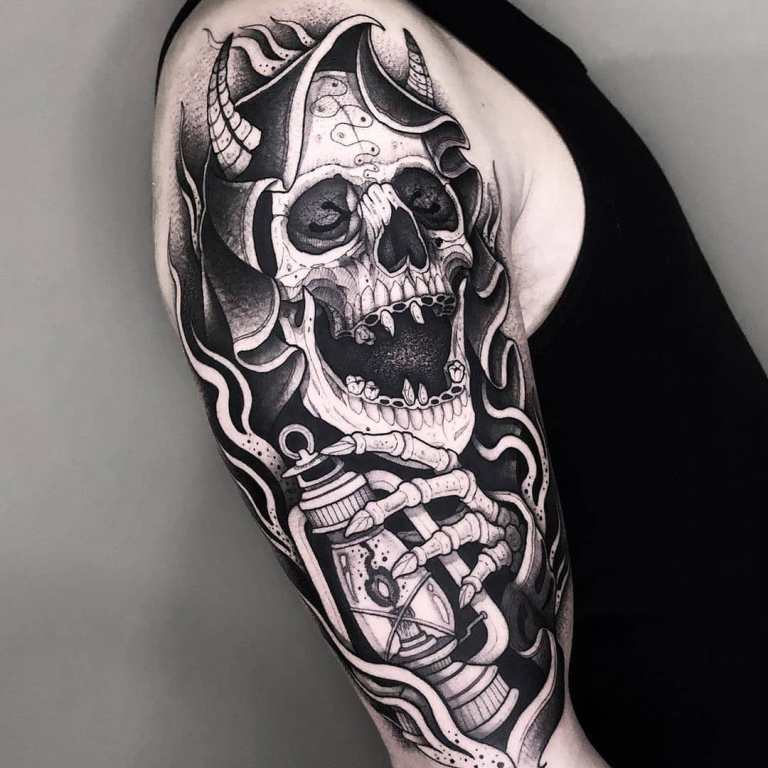

The main areas of the body where the tattoo can be placed:
- on the forearm;
- on the back;
- on the arm.
In general, such images can be placed anywhere: the choice depends on your own preferences. But if the image is clear and legible, it is better to put a tattoo on the back or other parts of the body, hidden clothing to avoid problems with the dress code.
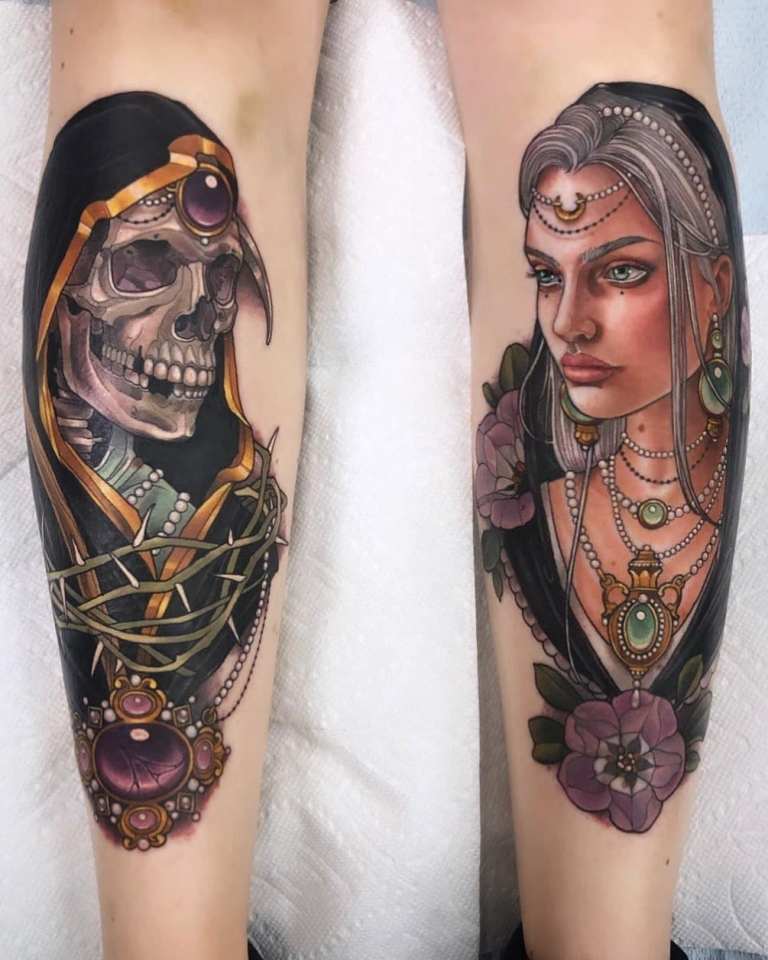

A miniature picture, made in the style of linework, can be placed even on the wrist or finger. At that time, a volumetric and high-quality image implies extensive areas of the body, such as the chest, back or arms.
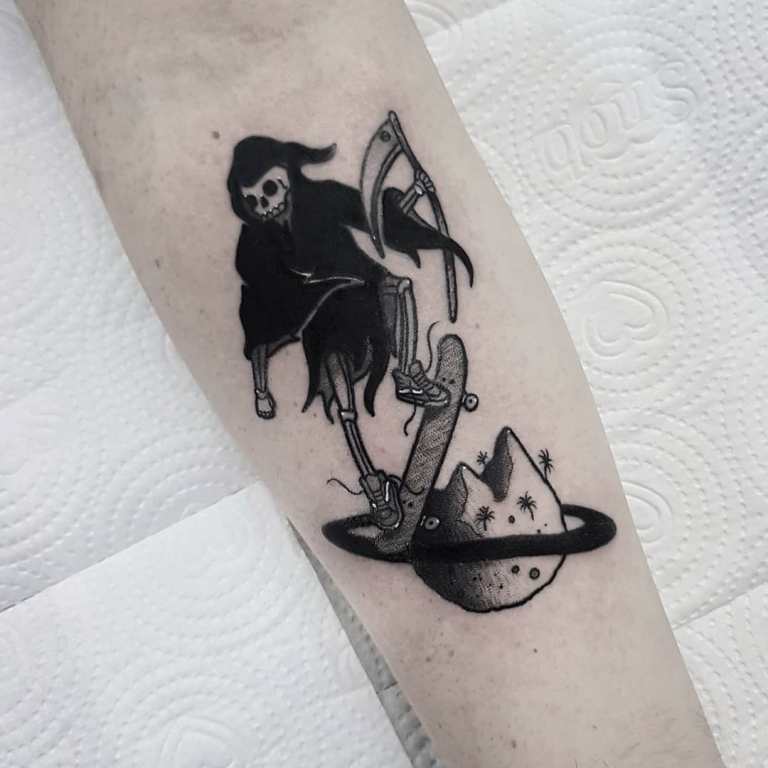

Men predominantly apply death with a slash on the arm, back and leg. Male representatives also use the shoulder and neck for sketches, but they usually correspond to only partial portraits of the image, such as the braid or only the face under the hood.
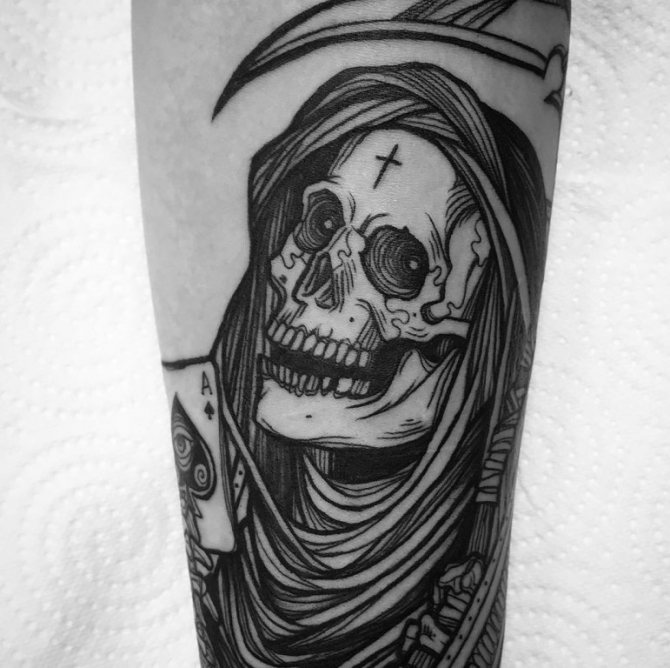

Unlike men, girls are less likely to get death tattoos in prominent places. Ladies give preference to non-standard images, hiding them under clothing. These are mainly the abdomen, thighs and sides. Although this is just a statistic, there are always exceptions to the rule.
Where to get a Sak Yant tattoo?
Today, many people see Thailand as the best place to get the most exquisite ritual tattoos, as well as a country where you can learn this art. Every year, hundreds of foreigners come to Thailand in search of the original and magical Sac Yant tattoos. In all of Southeast Asia, Thailand is the country with the largest number of followers. Sak Yant is performed all over the country in the Temples of Bangkok, Ayutthaya and Northern Thailand.
- By far one of the most famous Yantra tattoo Temples is considered Wat Bang Phra in Nakhon Chai Si in Thailand's Nakhon Pathom Province. The power of sacred tattoos diminishes over time. Therefore, to restore the power of tattoos, Sak Yant masters perform the sacred ritual of Wai Kru with their followers every year, the main point of which is to pay homage to the teacher. The most impressive Wai Kru ceremony in Thailand is performed at the Wat Bang Phra Temple. It is noteworthy that Ajarn Noo Kampai, perhaps the most famous Sak Yant specialist in Thailand, trained at this Temple.
- One of the famous Temples in Northern Thailand is Wat Keo, which means "needle". It is located in San Patong, not far from Chiang Mai and the home of Master Phra Ajarn Gamtawn, who died in Chiang Mai on September 14, 2010.
- In Lum Phli district on the north side of Ayutthaya, Ajarn Kob and his son Ajarn Oh are the most famous masters of the Sac Yant tattoo.
Real magical Sak Yant tattoos are done by famous and not so famous masters. If you do not care about "magic" component of the tattoo Sak Yant, you can apply to any tattoo parlor, which in any resort area you will find easily.
One of the centers, where you can get a tattoo Sak Yant is a Buddhist monastery Wat Bang Phra (Wat Bang Phra) is a Buddhist temple in the Nakhon Chai Si district of Nakhon Pathom Province, about 50 km west of Bangkok. The name can be translated from Thai as "Temple of a few monks" or "Temple of a few faces of Buddha" (from Thai Bang - "a few", and Phra - "monk", "Buddha image").
Magic Tattoo Festival every spring at Wat Bang Phra (photo)
Now a little bit about the festival - something of a spectacle. It starts the night before. Many people come to the temple, wishing to make a Sak Yant or upgrade an old one from his master (it is believed that over time the power of the Sak Yant decreases and it must be renewed).
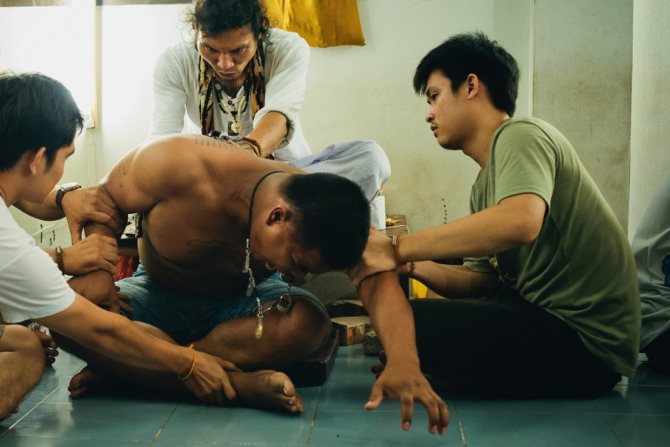

The rest of us sleep in our rooms, outside, on the floor, on the ground, or in tents...
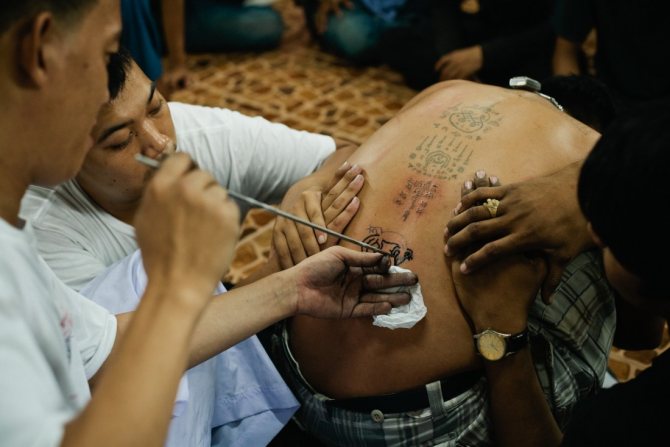

Already during the application of magical tattoos on the night before the festival, some begin to fall into a trance, while acquiring the properties of their tattoos: the image of a tiger gives a person the power of the tiger, the image of a monkey - the properties of a monkey, etc.
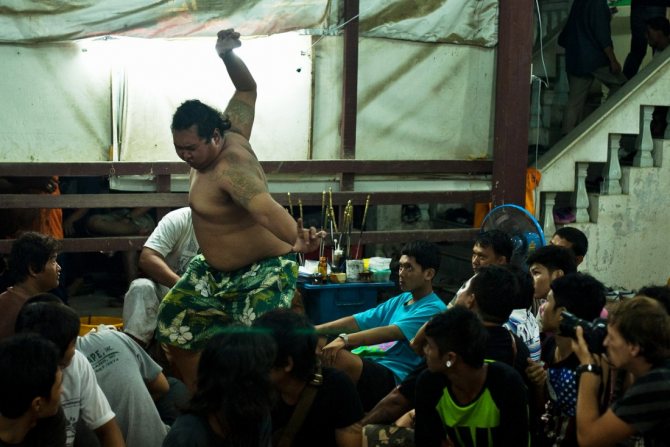

In the morning you can eat for free on the temple grounds. Lots of people and lots of food... The official part of the festival begins.
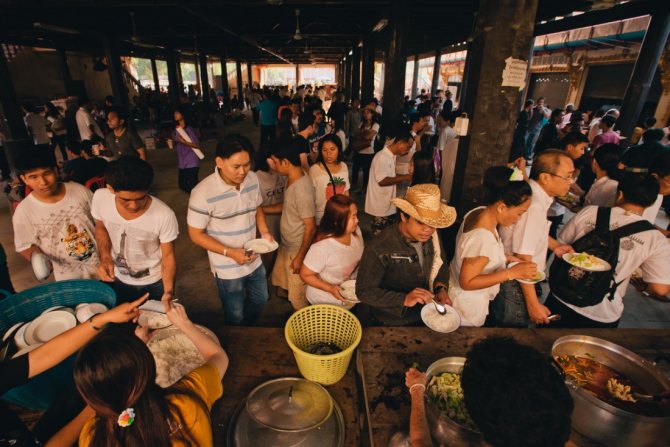

The action takes place in the square on the temple grounds. Hundreds of people sit on mats on the ground in the sunlight. Some begin to fall into a trance and run out to the stage (or crawl out, depending on the animal depicted on the person).
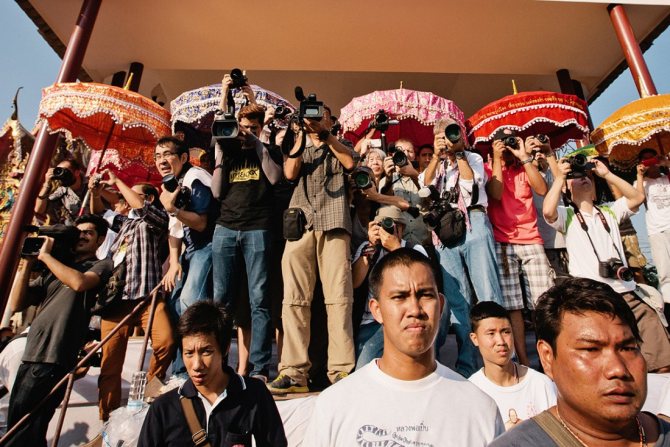

The photographers at first outnumber these people, which creates the effect of being on a kind of hunt.
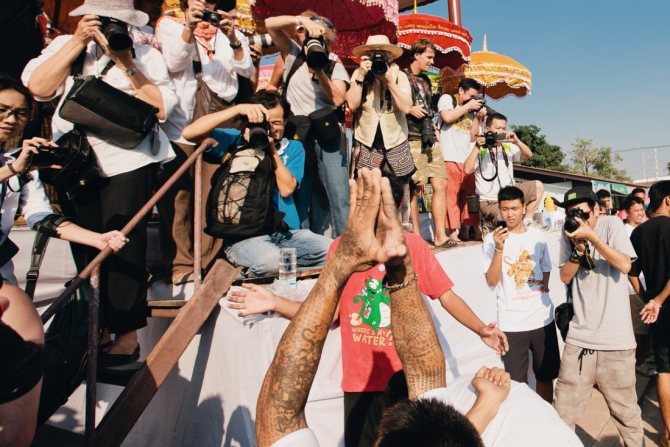

And then the people around you start to go crazy...
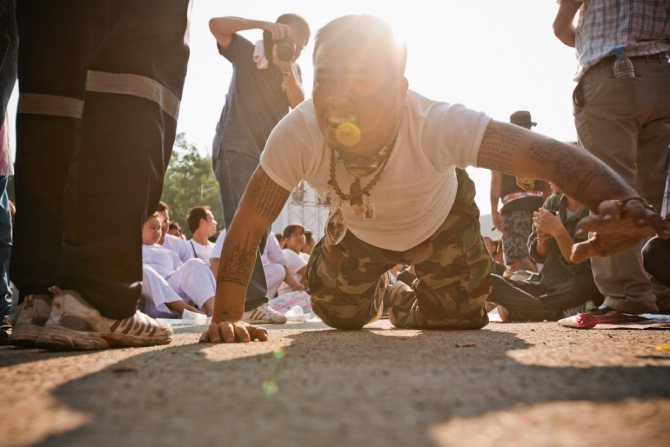

Turn into crocodiles,
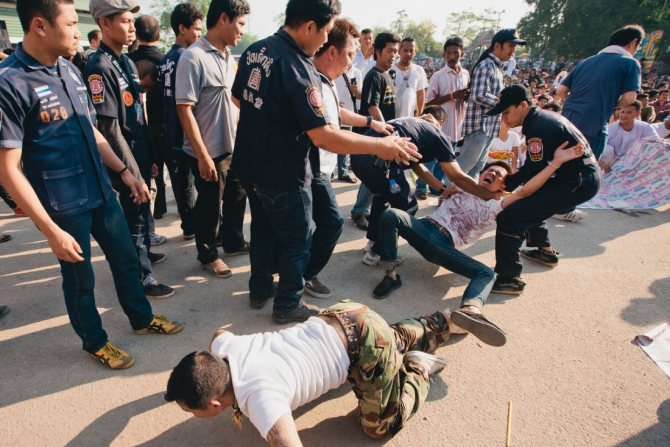

tigers...
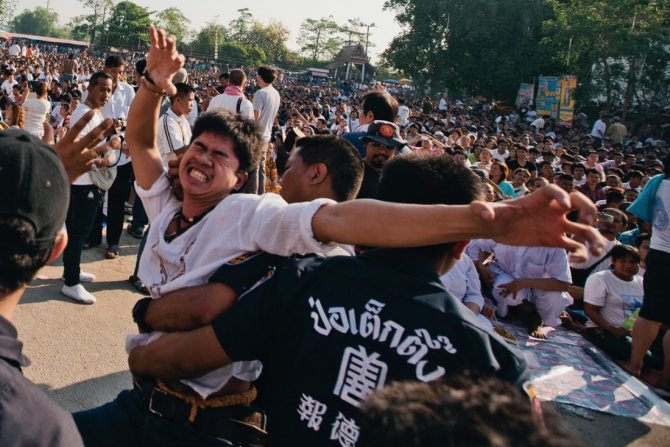

monkey kings.
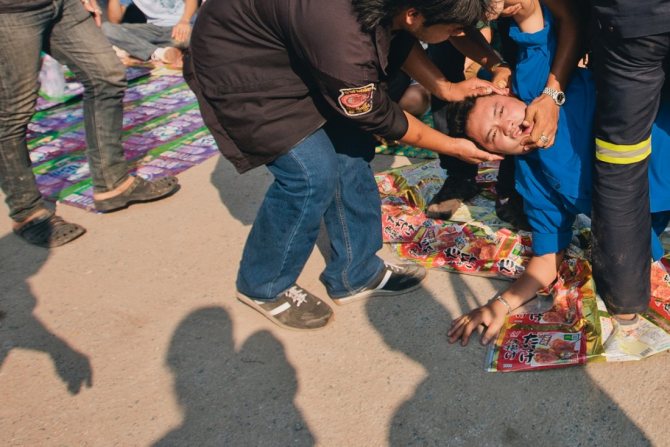

Toward the finale, when the main monks are about to enter the stage, more and more people fall into a trance. Sometimes the situation gets out of control and it seems that you are about to be trampled on from some unknown direction - you can only see the dust and hear the stomping of people rushing somewhere...
History
There is no written evidence about the date of its foundation but the architecture of its main hall suggests it dates from the late Kingdom of Ayutthaya while the mural paintings on the walls of the prayer hall suggest a likeness to the works of King Rama III and King Rama IV.
The former abbot of the temple, Phra Udom Prachanart (better known as Luang Por Phern), was a famous meditating monk, famed for his ability to cast effective spells and his talent in interpreting the Buddhist canonical texts of the Tripitai. As abbot of Wat Bang Phra, he organized several charitable structures through which donations were collected from the faithful, which was a significant innovation for those times.
Of most historical interest are the well restored prayer rooms of the temple, as well as the curious artifacts of the temple museum.
The temple is famous for the daily ritual of sacred tattoos Sak Yant (Sak Yant), which wishing to apply the temple tattoo master - living here monks. Every year in March, there is a festival of sacred tattoos. Information about the festival is fairly easy to find in public sources, while information about the day-to-day activities of the temple is very scarce, so we describe them below.
So, the process of getting a tattoo in a daily ceremony at Wat Bang Phra Temple outside of festival activities is as follows:
Preliminary stage.
Those wishing to receive a tattoo must arrive at the temple no later than 8am. At the temple, they will be expected to make offerings in the form of flowers and cigarettes (price of cigarettes for February 2011 - 70 baht), and cigarettes at the end of the ceremony will be returned to the vendors in exchange for money, which, in turn, will go to the maintenance of the temple. Before entering the temple premises, one must remove their shoes and take their place in the waiting line. The donations are divided into piles of 18 to 30 offerings per pile (most often 20), and stacked in the center of the hall. A monk illuminates these offerings, and those who have donated are invited to a simultaneous tattooing session. When the tattooing is completed, the next batch of offerings is blessed and the next group of people is invited.
Tattoo Options
Immediately at the entrance to the temple a huge banner catches the eye, displaying various tattoo designs. Unless you opt for a specific tattoo, a monk will default to one of the simple designs from the very top of the table.
The process of tattooing
Before being "on the receiving end" of the monk themselves, those sitting next in line usually help the master hold the one being tattooed at the moment. A thin needle about 45 cm long and 4 mm thick is used to apply the design. It is bifurcated at the end, so each touch of the needle leaves two ink dots on the skin. Under the monk's hand in a special pot about 8 more such needles usually wait their turn in a disinfectant solution. Sometimes the monk ritually sharpens the needle with sandpaper before beginning. Then a version with the chosen design is selected among the rubber templates. The template is dipped in ink and then used to leave an imprint of the future tattoo on the skin. Before he begins to translate the print into a tattoo, the tip of the needle is dipped into a special mixture consisting of palm oil, Chinese charcoal ink and snake venom. He then begins to imprint the pattern with the needle. Each tattoo requires about 3,000 needle strokes. But the monk works in honed, quick movements, dipping the needle in the ink every 30 seconds.
When the tattoo is applied, it is blessed with a special mantra, Ghata, which activates its sacred power. Dark gray ink is used for tattoos for men. For women, transparent ones are used and the monk works on them with gloves, so as not to touch a woman's body.
Health Safety
The degree to which the needles and ink are disinfected is not known. Potentially, getting a tattoo at Wat Barng Phra temple puts pilgrims at risk of HIV and hepatitis B and C. There are over 1 million officially registered AIDS patients in Thailand. However, according to the UNAIDS report of 2006 "On the Global AIDS Epidemic," among these cases there have been no cases from tattoo needles. Because inside the needle itself can not accumulate blood in such quantities that it is enough to transmit the infection.
- Tours to Thailand from all possible tour operators first hand Pegas, Tez Tour, Coral Travel, Anex, etc.
- Search and compare prices by individual resorts and hotels.
- Hot deals first-hand. Real-time information updating, instant notification on a new hot offer.
- Booking and payment by bank card.
- Use the same booking tools as the travel agencies, eliminate the extra link!
FIND YOUR TOUR NOW!
www.bibliothai.ru © 2013. All rights reserved. Illegal copying is prosecuted. About copying and distribution of materials on this site.
